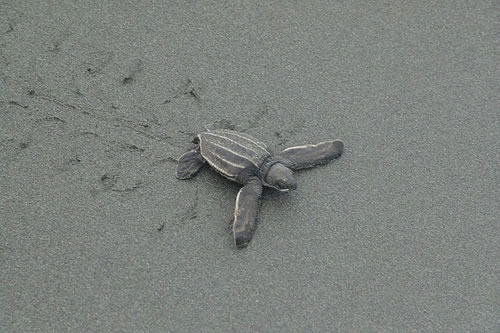|

Image: http://www. flicker.com/images/jungle_boy (creative commons license)
Description |
| |
| The Leatherback Sea Turtle is the largest turtle in existence. Individual Leatherback Sea Turtles can weigh up to 1,400 pounds. Unlike most sea turtles, the Leatherback lacks a bony shell. Its carapace is covered by its oily skin. The carapace features seven bony ridges. The Leatherback is large, dark greenish or black in coloration, with a large head and short tail. The underparts, however, or whitish. Its flippers are specially adapted for long-distance underwater travel and lack claws. The Leatherback Sea Turtle is the world’s fourth largest living reptile. In addition, it is the world’s deepest diving and fastest swimming reptile. Individuals have been found at depths exceeding 3,800 feet and have been clocked at speeds approaching 20 miles per hours. |
| |
Diet |
| |
| Leatherback Sea Turtles consume large quantities of jellyfish and will swim thousands of miles in search of blooms. Leatherbacks often ingest plastic bags which they mistake for jellyfish. Plastic bags cause major intestinal problems for these turtles and often result in their deaths. |
| |
Habitat and Range |
| |
| Leatherback Sea Turtles can be found throughout the world’s temperate and tropical oceans. Major nesting areas are located in Florida, Costa Rica, the Atlantic coasts of northeastern South America, Gabon (in eastern Africa) Malaysia, and northeastern Australia. Other nesting sites are located in the Bahamas and other Caribbean islands, Central America, Mexico, northern South America, western Africa, southeast Asia, China, India, and the islands of western Oceania. |
| |
Breeding |
| |
| Female Leatherback Turtles nest on their beaches of birth and excavate a nest hole above the high-tide line. Females often lay multiple clutches with each clutch containing about 100 eggs. After each clutch is deposited, the female carefully covers the eggs with sand using her back flippers. After about two months, the eggs hatch (always at night) and the hatchlings use moonlight to direct them toward the sea. Extraneous light from roads and houses can confuse the hatchlings and lead them astray. Young Leatherback Turtles are extremely vulnerable to predation from dogs, cats, raccoons, gulls, predatory sea birds, and vultures. |
| |
Status |
| |
| The Leatherback Sea Turtle is listed as critically endangered, though major conservation efforts in different parts of the world have been undertaken to protect this species. Major threats to this species include the use of large fishing and shrimping nets. In many parts of he world, TED’s (Turtle Excluder Devices) are not mandatory and thousands drown every year as a result of being caught in these nets. As previously noted, many die after ingesting plastic bags mistaken for jellyfish. Today, it is illegal throughout the world to intentionally kill or harm the Leatherback Sea Turtle. Mayumba National Park in the African nation of Gabon was created specifically to protect nesting Leatherback Turtles. As many as 30,000 female turtles lay their eggs at Mayumba. |
| |
|